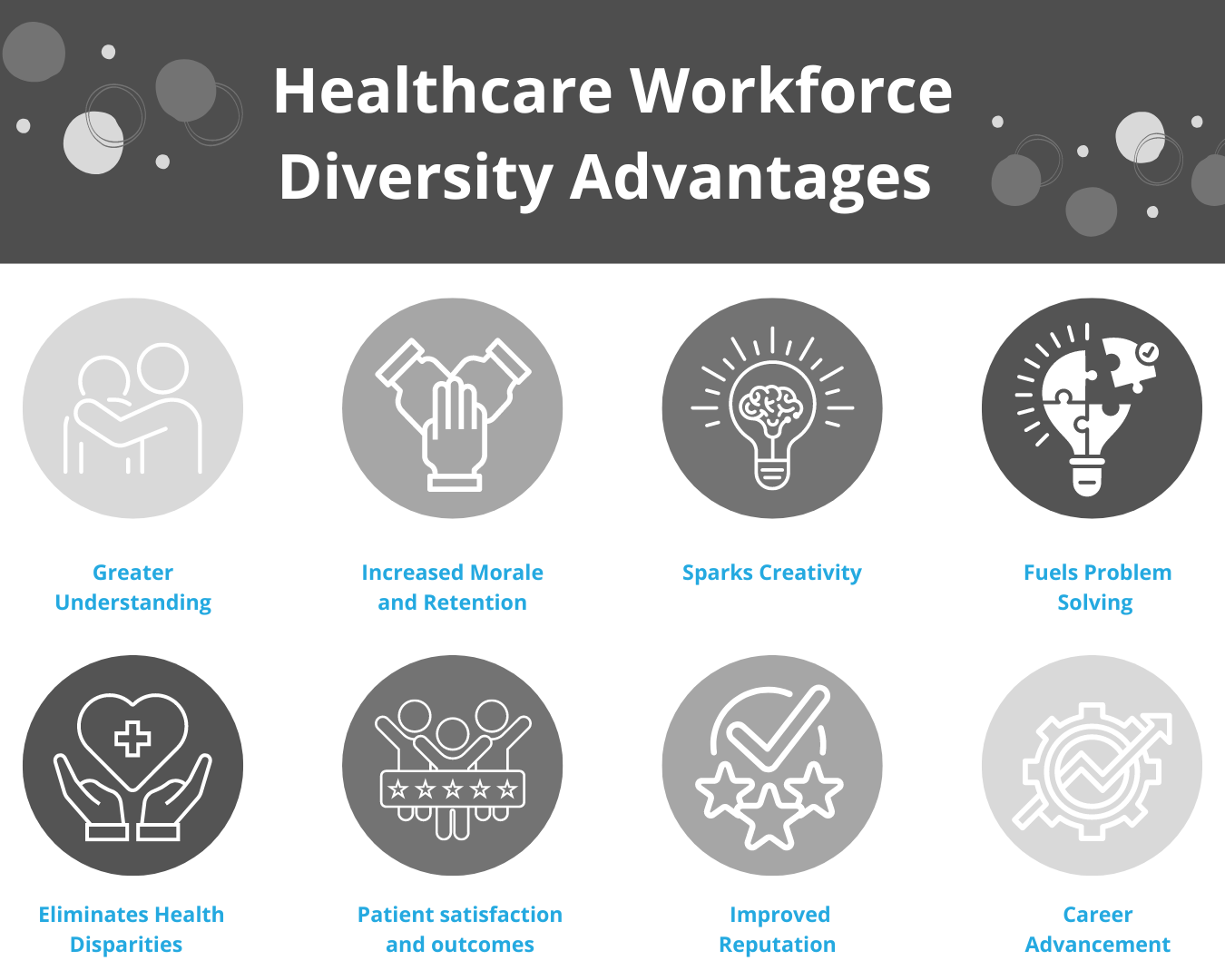A major Human Resources (HR) initiative is overseeing diversity, equity and inclusion (DEI) – a component that lends itself critically important within healthcare. Diversity refers to the varying demographics of people within a workforce that can include differences in race, ethnicity, age, gender identity, sexual orientation, physical abilities and disabilities, political beliefs, religion, language, socioeconomic background, education and culture. Equity entails fair treatment, opportunity, and advancement for individuals of any background. Inclusion determines whether an organization cultivates a culture of respect for individuals from varying backgrounds that allow members to participate and contribute without fear of discrimination or bias.
Current Workforce Diversity Trends
Though patient communities display a wide range of diversity, healthcare systems fall short in reflecting a similar diverse workforce of the communities they serve.

Promoting diversity within healthcare is imperative, with increased diversity having several ethical and strategic advantages that benefit minority employees, minority patient groups, and healthcare organizations themselves. Greater diversity, equity and inclusion helps deliver effective healthcare outcomes by promoting:
- Greater understanding among associates and patients
- Increased employee morale and retention
- Sparks creativity
- Improves team problem-solving
- Helps eliminate health disparities
- Increases patient outcomes and satisfaction
- Improves brand reputation
- Enables greater career advancement

Diversity in Healthcare Systems
What is cultural competence?
Cultural competence entails the set of knowledge, skills, and behaviors that equip healthcare practitioners in effectively understanding and interacting with patients from varying sociocultural backgrounds. This ensures culturally sensitive and respectful interactions towards patients, while also providing optimal care and effective communication.
Maintaining a cultural competent workforce yields a wide range of benefits to healthcare organizations from increased employee wellbeing and productivity, to improved patient outcomes and brand reputation.
1. Greater Understanding
Healthcare workforce diversity has direct impacts among coworkers and patients. Exposure to workforce diversity can help create an environment of understanding, compassion and empathy towards those from different backgrounds. Being within a diverse environment itself changes behavior and mindsets. Studies demonstrate that those in the presence of diverse individuals showed greater empathy, as well as a greater capacity for being openminded.
A greater understanding toward work associates and patients from various social backgrounds builds an environment of inclusiveness and belonging, both of which have positive effects on team morale, workplace productivity, employee retention, and patient outcomes (discussed further below).
Exposure to varying backgrounds can also help reduce biases while strengthening relationships between coworkers and patients. Biases refer to internalized prejudices towards someone or something. Biases can be overt or subconscious and can often result in unfair treatment. By acknowledging biases and learning from different cultures, greater team cohesion and patient interactions can be achieved.
2. Higher Employee Morale
Creating a diverse workplace fosters a sense of belonging and inclusiveness for healthcare employees, which in turn creates a stronger workplace culture and community for organizations. Nurturing a safe environment for all employees of diverse backgrounds improves team morale, increases productivity, and improves employee retention.
3. Enhanced Creativity
Diversity enables enhanced creativity in addressing complex problems. A culture-friendly environment that embraces diversity allows minority employees to feel included, accepted and empowered to share ideas while reducing the feeling of being rejected. People with varying perspectives, experiences, and knowledge can contribute their unique input in crafting creative solutions. Adversely, lacking a diverse workforce can cause minority employees to conform. The fear of rejection inhibits employees to contribute their unique talents, creative approaches, and valuable input.
When people are surrounded by those similar to themselves, they tend to assume that everyone holds the same perspectives. This prevents people from challenging viewpoints, limits the range of information exchanged, and creative solutions that would otherwise be reached based on a diverse set of input.
4. Problem Solving
In conjunction to enhanced creativity, diverse perspectives, opinions, and unique information fuel better problem solving and decision-making processes. An array of varying inputs enables teams to identify and reduce blind spots and come to creative solutions to complex problems. Studies frequently demonstrate that teams composed of diverse individuals are greater problem solvers and outperformed their homogenous counterpart teams.
5. Eliminate health disparities
Health disparities among minority groups is a persisting issue. Healthcare providers exhibiting explicit or unconscious biases towards patients of various backgrounds affect the quality of care groups receive, furthering unequal treatment. Some evidence suggests that health providers from various racial groups tend to hold biases unconsciously that display positive attitudes towards white patients and negative attitudes towards people of color. This often results in a distrust of minority groups toward their healthcare practitioners, negative interactions with health providers, and overall reluctance in seeking medical attention.
A key approach in minimizing health disparities is developing a diverse healthcare workforce that reflects the community it serves. Having employees that represent varying groups enables positive patient relationships, establishes trust, and increases positive patient outcomes among minority groups. Additionally, a diverse environment allows practitioners of all backgrounds to better understand and relate to culturally diverse patients and employ culturally competent interactions.

6. Increase patient satisfaction and outcomes
With a diverse patient population, fostering a culturally-safe environment is imperative for successful health outcomes. Lacking diverse employees can run the risk of patients feeling misunderstood, create distrust, as well as compound language and cultural barriers.
Having diverse practitioners can help patients feel represented and understood. This allows patients to feel safe, less anxious, and more confident about the care they receive. Feeling safe and understood also empowers patients to seek medical attention, speak up, ask questions, discuss treatment plans, and comply with medical advice, allowing for successful patient outcomes and satisfaction.
Diversity among healthcare professionals also allows for communication and cultural barriers to be appropriately addressed for the correct treatment. Language and communication barriers can lead to adverse effects such as a misdiagnosis, poor care, unequal treatment, and noncompliance – all leading to negative patient outcomes. It is essential to have employees that can effectively and accurately communicate all related health information, services, treatment and outcomes.
Lastly, diverse input from a workforce with varying backgrounds, experiences, and knowledge helps creatively problem-solve patient issues. Having limited perspectives can cause teams to overlook critical information regarding patient diagnosis or medical history which negatively affects patient care.
7. Improved Reputation
Fostering a culturally-friendly environment that welcomes varying backgrounds and embraces differences positively improves reputation for healthcare organizations. While strategically it’s wise to include diverse groups in terms of the endless benefits diverse individuals contribute to organizations, it’s also ethically imperative to do so. Having a diverse environment attracts like-minded candidates to join your organization, as well as draws patients from various backgrounds as well. This allows organizations to connect with its community internally and externally in a powerful and meaningful way.
8. Employee Advancement
Greater representation within high-level positions is critical in avoiding tokenism and gives institutions the opportunity to practice inclusion. Simply having a workforce consisting of different people is not enough. In order to truly cultivate and embrace diversity, healthcare organizations need to empower programs and opportunities for career advancement among minority groups. Research consistently demonstrates that businesses and corporations with greater diversity in high-level positions outperformed competitors that lacked any diversity in similar positions.
Furthermore, greater representation in high-level positions allow minority healthcare practitioners to identify with a role model and mentor. Mentorship is an essential component within healthcare as professionals often seek guidance from mentors to help further their careers. Lacking diverse representation can impede employee career trajectories.
Improving Workplace Diversity
Often, HR is tasked with managing diverse teams, promoting a diverse workplace culture, and sourcing diverse skillsets. Increasing diversity is a major initiative and there are several ways to promote and maintain a diverse workforce within healthcare organizations including optimizing recruitment processes, creating a safe and welcoming environment, furthering opportunities for employees, and measuring results to further refine DEI opportunities.
Optimize Recruitment Processes
Auditing talent acquisition strategies is an essential step in understanding how candidates are sourced and how diverse the talent pool is. First, evaluate how job descriptions are written – this may seem trivial, but its content can affect who applies. Create job descriptions that don’t deter a group of people from applying and encourages diverse applicants and perspectives. This helps position your organization as diversity-inclusive and welcoming.
Developing an effective recruitment and hiring strategy that outreaches to a diverse talent pool can boost DEI inclusivity. Utilizing managed service providers or external recruitment agencies can significantly bolster efforts in reaching greater candidates from different backgrounds. Often, external agencies have a large pool of applicants, networks, and resources to source diverse candidates. Additionally, having a third party source candidates on your behalf can help eliminate implicit bias present in current recruitment processes.
Another measure healthcare organizations can consider is standardizing the interview process. Standardizing the interview process so that it is consistent and equal for all candidates helps minimize hiring bias and gives all candidates equal opportunity. For institutions conducting in-house recruitment create a set of standardized questions and processes that all candidates must equally follow.
For organizations using vendor management technology, consider utilizing virtual interview tools that allow a set of standardized questions to be prompted to all candidates. Furthermore, virtual interview tools, such as StaffBot’s, allow several hiring members to have access to virtual interview videos at any point in time. With inputs from several different people, hiring bias can be reduced than when a single person is conducting an interview.
Welcoming Environment
Creating a safe environment that promotes diversity is fundamental in nurturing workplace happiness and long-term retention. Encouraging an environment that promotes inclusivity, support, and valuing all employees helps build a healthy workplace where people can feel they belong. Furthermore, a workplace that takes immediate action in instances of bias and discrimination further helps promote a safe working space for all individuals.
Opportunities
Providing opportunities, resources, and programs for advancement and leadership that is equally accessible, empowers individuals from various backgrounds to join and stay with organizations. It’s critical to go beyond having diverse employees, but to actively include members in greater opportunities that contribute to employee and company wellbeing.
Training Programs
Investing in training resources has several benefits in educating employees and enabling greater understanding. Trainings on cultural skills, cultural differences, bias awareness and effective communication equips teams with essential education and cultural skills in working with members from various backgrounds.
Measuring Results
Creating constructive, fundamental changes in promoting greater DEI for your healthcare workforce is ethically important and positively impacts employees, patients, and your brand. Implementing changes to promote DEI necessitates consistent monitoring and measuring in order to understand whether efforts are working, or if changes need to be made.
Vendor management technology, whether through the use of an MSP or directly utilized by your organization, provides insightful data regarding DEI initiatives (and many more reporting capabilities). With all sources of data integrated within a single source of record, along with its AI capabilities, a vendor management system collates all data from your organization to create real-time custom, standard, and ad-hoc reporting. Such analytics provide powerful insights to institutions with varying business goals. Use powerful insights to monitor progress or pinpoint areas of inefficiencies to create better processes and results.
Let StaffBot help with your HR initiatives
With extensive knowledge on talent acquisition, StaffBot’s multi-faceted recruitment services help source a diverse candidate pool for your healthcare workforce. From MSP services to providing vendor management technology, StaffBot’s total talent solutions works alongside your organization to customize a tailored approach in addressing your organization’s pressing recruitment needs. With StaffBot, we aim for a true partnership. Connect with an expert below to find out how we can boost your healthcare recruitment strategy.
Connect with an expert or request a demo
"*" indicates required fields





0 Comments